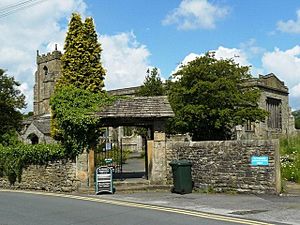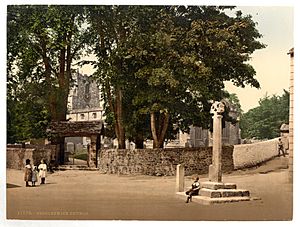Church of St Alkelda, Giggleswick facts for kids
Quick facts for kids St Alkelda's Church |
|
|---|---|
| Church of St Alkelda, Giggleswick | |
 |
|
| 54°04′19″N 2°17′20″W / 54.072°N 2.289°W | |
| Location | Giggleswick, North Yorkshire |
| Country | England |
| Denomination | Church of England |
| Weekly attendance | 40 (2018) |
| History | |
| Status | Parish church |
| Dedication | Alkelda |
| Architecture | |
| Functional status | Active |
| Architectural type | Early English Perpendicular |
| Specifications | |
| Length | 132 feet (40 m) |
| Administration | |
| Parish | Giggleswick |
| Benefice | Castleberg |
| Deanery | Bowland and Ewecross |
| Archdeaconry | Richmond and Craven |
| Diocese | Leeds |
The Church of St Alkelda in Giggleswick, North Yorkshire, England, is a very old and special Anglican church. It's dedicated to a mysterious Saxon princess named Alkelda. For a long time, St Alkelda's was the main church for a large area, like a "mother church," until another church was built in Settle, North Yorkshire in 1838. People still come to this church today for worship.
Contents
Discovering St Alkelda's Church History
People believe a church has stood on this spot since the time of the Saxons, many centuries ago! The church you see today was mostly built in the 1300s and 1400s. It has been updated and repaired several times since then, including in the late 1800s and early 2000s. Some historians think an earlier church might have been damaged during conflicts around 1319. The first time anyone wrote about a church in Giggleswick was in 1160.
Who Was St Alkelda?
St Alkelda's Church is one of only two churches in England named after this Saxon princess. The other is in Middleham, also in North Yorkshire. Legend says that Alkelda faced great danger during the Viking invasions. Her name might come from Alchhild or Halig Keld, which means "holy spring." Interestingly, there was once a holy spring in Giggleswick that fed a lake called Giggleswick Tarn. It's possible the church's name is connected to this special spring.
Another idea is that the church in Giggleswick was linked to the one in Middleham very early on. People believe Alkelda was buried in Middleham. Perhaps the Giggleswick church became a smaller, connected church after the kings of Northumbria took control of the Craven area around 670 AD.
Changes Over Time
Records show that in 1200, a person named Henry de Puteaco gave the church at Giggleswick to the monks at Finchale Priory near Durham. It stayed with them until about 30 years before a big change when many churches and monasteries changed ownership.
In 1507, land was set aside to build a "grammar school for boys" nearby. This school, Giggleswick School, has a long history with the church. Students and teachers from the school used to attend services here. They even helped pay for gas lighting so they could have services later in the day! The school's former and current students helped pay for a major renovation of the church in 1880. This close connection continued until 1901, when the school opened its own chapel.
Church Design and Features
The church's design mixes two old English styles: Early English and Perpendicular. It's described as a "spacious and handsome structure" with a strong, square tower. Most of the beautiful stained glass windows are from the 1400s. However, a newer window was added in the 2010s. This special window shows St Alkelda in a challenging situation, suspended over water. It was found by two churchwardens in the parish room and is thought to be from between 1920 and 1930.
The church's organ, made by Abbott and Smith, was installed in 1892. It was carefully restored in 2005 by a company from York.
St Alkelda's Church is connected to the other Anglican church dedicated to St Alkelda in Yorkshire, the Church of St Mary and St Alkelda, Middleham, by a 33-mile walking path called St Alkelda's Way.
In 2020, the church received permission to put solar panels on its roof. This helps the church save energy and be more environmentally friendly. No one objected because the panels are on a part of the roof that can't be seen from the ground.
Churchyard: A Place of Rest
For many centuries, St Alkelda's churchyard was the only official burial ground for the entire parish. It's estimated that thousands of people have been buried there over hundreds of years. A famous TV chat-show host, Russell Harty, was buried in the churchyard in 1988.
Understanding the Parish and Its Changes
The word "parish" refers to the area a church serves. The first mention of clergy (church leaders) here was in 1160. Back then, the parish was part of the Diocese of York. Over the years, the parish moved between different dioceses (larger church administrative areas). In 1836, it joined the Diocese of Ripon. Then, in 1919, it moved to the Diocese of Bradford. In 2014, it became part of the Diocese of West Yorkshire and the Dales, which then became the Diocese of Leeds in April 2016.
Even though Settle is the main market town nearby, St Alkelda's was always considered the "mother church." This meant it was the most important church for a very large area. This changed when the Church of Holy Ascension was built in Settle in 1838. The original parish that St Alkelda's looked after was huge, covering over 18,500 acres! It included Giggleswick, Langcliffe, Rathmell with Wigglesworth, Settle, and Stainforth. Giggleswick was the main church town until 1851, when Langcliffe got its own parish. Settle followed in 1898.
Today, St Alkelda's serves a smaller area, the Parish of Giggleswick. In 2018, about 40 people attended services each week.
Leaders of St Alkelda's Church
St Alkelda's Church has had many dedicated leaders, called vicars, throughout its long history. Records show vicars serving the church as far back as 1230! These leaders have guided the community and helped maintain the church for centuries. The current vicar, Reverend Julie Clarkson, began her role in 2019.


